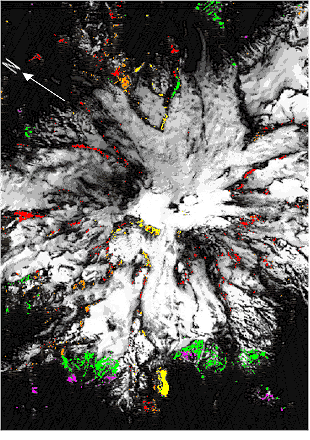Sector Collapse
Collapse
Sector Collapse
- What is Sector Collapse?
- Sector collapse, or edifice failure, is the collapse of a portion of the volcano, and is often a result of earthquakes, rising magma, and abundant precipitation in combination with high relief, steep slopes, and unstable or altered rock (Zimbelman, 1996:15). Sector collapse often creates lateral blasts or far-traveling lahars.
- Sector Collapse at Mount Rainer?
- Mount Rainier has all the necessary ingredients for a sector collapse. In the past, there have been at least three major sector collapses at Mount Rainier (Crandell, 1971), the largest of which removed the northeast slope and summit and began the Osceola Mudflow, Rainier's largest lahar (Sisson, 1998).
 One of the major concerns at Mount Rainier is the amount of rock that has been hydrothermically altered. Like most statovolcanoes, Mount Rainier is composed of andesitic rock; when andesitic rock is exposed for long amounts of time to hot liquids or gas, a physical, chemical, and isotopic change occurs (Zimbelman, 1996:95). The end result is a rock structure that contains clay material - much weaker than andesitic rock and able to flow long distances (Crowley, Zimbelman, 1997:559). Hydrothermal alteration has been an issue at Mount Rainier for quite some time, as the oldest rock found there has shown signs of alteration, and is probably still occurring today since there are near-boiling point furmaroles in the summit area (Zimbelman, 1996:96).
One of the major concerns at Mount Rainier is the amount of rock that has been hydrothermically altered. Like most statovolcanoes, Mount Rainier is composed of andesitic rock; when andesitic rock is exposed for long amounts of time to hot liquids or gas, a physical, chemical, and isotopic change occurs (Zimbelman, 1996:95). The end result is a rock structure that contains clay material - much weaker than andesitic rock and able to flow long distances (Crowley, Zimbelman, 1997:559). Hydrothermal alteration has been an issue at Mount Rainier for quite some time, as the oldest rock found there has shown signs of alteration, and is probably still occurring today since there are near-boiling point furmaroles in the summit area (Zimbelman, 1996:96).- New geological studies indicate the areas of Mount Rainier that have been most altered lie in an East-West Zone across the volcano (Zimbelman, 1996:84). The colors on this satellite image show areas that have been hydrothermally altered. Yellow represents intensely altered rock, composed of clay and silica. Orange, red, green, and magenta, respectively, show decreasing types and stages of alteration (Crowley, Zimbelman, 1997:561).
- Mount Rainier is not alone in its potential for sector collapse - there have been repeated instances throughout history. The most recent in the Cascades occurred in 1980 at Mount St. Helens, when the side of the volcano collapsed leading to an immediate lateral blast.
Click Here - Learning From Experience Sector Collapse
Next:
Continue with Glacial Outburst Floods.